

Teaching K 12 Literacy in digital age. 5-Minute Writing Conferences. Writing teachers know that students need to write a lot and get meaningful feedback in order to improve their writing. We also know what it feels like to be buried under a pile of student writing that needs to be read and commented on, and although there are many strategies that can help us deal with this paper load, it’s still a daunting part of our work with students. When I initially considered conferencing with each and every student in my classes to reduce the need for written comments, I was apprehensive about the time commitment, but with the help of a colleague who had made it work in his classroom, I recently took the plunge and did writing conferences with my students—and it had a huge impact on my classroom and my students’ learning.
Before the Conferences As I did this, I also made notes about some overall strengths and growth areas for following up with whole class mini-lessons. Next I had students reflect on their papers with the targeted questions on this handout. Easy Words to Use as Sentence Starters to Write Better Essays. Improve Your Writing Today!
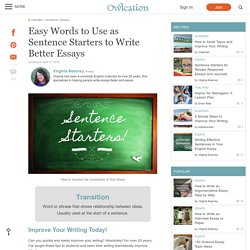
Can you quickly and easily improve your writing? Absolutely! For over 20 years, I've taught these tips to students and seen their writing dramatically improve. Why? Using transition words helps you resist the habit of using a simple subject-verb sentence structure.Transitions link your ideas more effectively and create more nuanced meaning.Finally, transitions make your writing sound more professional and less like spoken language. Grammar and Thongs. A Writing Strategy That Works For Every Student, Every Time - By Terry Heick Writing is difficult to teach, if for no other reason than it is also difficult to do.

Put simply, writing is the documentation of thinking. Because it’s been done in so many different format for so many different reasons for so many years, writing has become extraordinarily nuanced. Readers are conditioned not to just decode and interpret, but to recognize the purpose of even the most mundane choices–in diction, for example. New research shows what makes a difference in teaching literacy and why ‘evidence-based’ is not enough. Public discourse about schooling generally assumes that it’s in crisis.

The script goes something like this: There’s a problem and it’s big – really big! Test results show us Australia is going downhill and teachers need to be accountable. There are ‘evidence-based’ solutions but teachers are not using them. If they did, literacy standards would improve, test results would improve, and Australia would be among the best in the world again. Well we have some good news and bad news for you. The good news is our research, a long-term study of schools in communities in Australia experiencing high-levels of disadvantage, funded by the Australian Research Council, shows that teachers are indeed now implementing the ‘evidence-based’ local literacy agreements that they have been asked to implement and that their work includes a diverse range of research-informed approaches to literacy learning.
Use of common pedagogies Teachers used what we call common pedagogical approaches. Close. AER Video Library - Learning Goals and Success Criteria. This article gives you tips for setting... - Reading Australia. Improving student writing using a continuum. In an effort to improve student writing, teachers at this New South Wales school developed a writing continuum for students in Kindergarten to Year 10.
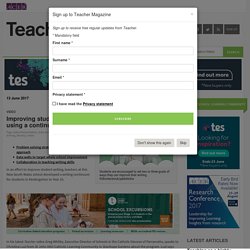
In his latest Teacher video Greg Whitby, Executive Director of Schools in the Catholic Diocese of Parramatta, speaks to Christina Luzi from St John XXIII Catholic Learning Community in Stanhope Gardens about the program. Luzi says that this program came about after staff at her school took a close look at their NAPLAN data. Online publication for school educators. Two teachers explain how an approach to literacy that incorporates an in-school book publishing program has contributed to an increase in engagement levels.

About two years ago, Noosa Pengari Steiner School was given the opportunity by the then Queensland Studies Authority to submit its high school courses for recognition. We were a young high school (about four-years-old), so writing the first course for recognition became an opportunity to imagine our school as we would ideally want it to be. We had already been looking at student engagement and how to improve it, understanding that engaged students are motivated students, and that motivated students achieve well academically and in the world. Authentic literacy - writing for a real audience. Imagine walking into your class and saying: ‘Today, you're going to write a letter ... but you're not going to send it, you'll be doing it in your school book.’
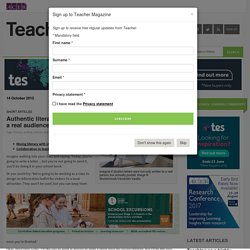
Or you could try: ‘We’re going to be working as a class to design an information leaflet for visitors to a local attraction. They won’t be used, but you can keep them once you’re finished.’ Okay, third time lucky: ‘I’d like you to work in groups to write a short story for young children, but I’ll be the only person who reads it.’
I’m exaggerating of course – you wouldn't ever say that to your students, but these rather uninspiring descriptions could be a fair reflection of how the literacy tasks work out. Now, imagine if those letters were not only written to a real person, but actually posted. What Motivates A Student’s Interest in Reading and Writing. The excerpt below is from the book “Building a Community of Self-Motivated Learners: Strategies to Help Students Thrive in School and Beyond,” by Larry Ferlazzo. This excerpt is from the chapter entitled “I Still Want to Know: How Can You Get Students More Interested in Reading and Writing?”
Let’s begin with a review of those essential qualities (needed to develop intrinsic motivation) in the context of reading and writing: ♦ Autonomy. A major Pew Research Center report (Lenhart et al., 2008) found that choice has an equally important role in teens feeling a desire to write (the story in Chapter 1 of my student who was energized by writing about football illustrates this point). Likewise, in reading, extensive research documents that teachers encouraging students to read books of their choice for pleasure is a major contribution towards students developing a positive attitude towards reading and a life-long interest in it (Leisure Reading Task Force, 20014, p. 2). ♦ Competence. What Doesn't Work: Literacy Practices We Should Abandon. The number one concern that I hear from educators is lack of time, particularly lack of instructional time with students.
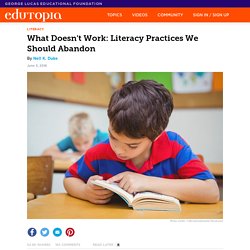
It's not surprising that we feel a press for time. Our expectations for students have increased dramatically, but our actual class time with students has not. Although we can't entirely solve the time problem, we can mitigate it by carefully analyzing our use of class time, looking for what Beth Brinkerhoff and Alysia Roehrig (2014) call "time wasters. " Consider the example of calendar time. In many U.S. early elementary classrooms, this practice eats up 15-20 minutes daily, often in a coveted early-morning slot when students are fresh and attentive.
Yesterday was _______. English and Language Arts Apps, Games, and Websites. 20 Guiding Questions To Develop A Digital Literacy Plan - 20 Guiding Questions To Develop A Digital Literacy Plan by TeachThought Staff For professional development around developing literacy plans–digital or otherwise–contact us today.

Teaching literacy is more than teaching simple reading skills: it can’t be done in five easy steps. If we truly care about all Australian children and young people becoming literate I believe it is vital we understand and define the complexity of literacy.
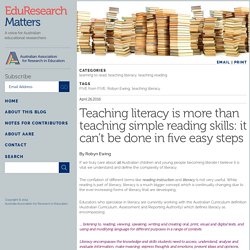
The conflation of different terms like reading instruction and literacy is not very useful. While reading is part of literacy, literacy is a much bigger concept which is continually changing due to the ever-increasing forms of literacy that are developing. Educators who specialise in literacy are currently working with the Australian Curriculum definition (Australian Curriculum, Assessment and Reporting Authority) which defines literacy as encompassing: For example, the Australian curriculum’s definition of literacy thus far exceeds the ‘key skills’ addressed in the recently launched FIVE from FIVE project proposed by the Centre for Independent Studies. FIVE from FIVE is being touted, with much fanfare, as some all-encompassing way of teaching children to read.
How To Use The Text Reduction Strategy To Improve Reading Comprehension - How To Use The Text Reduction Strategy To Improve Reading Comprehension by Andrea Heick.
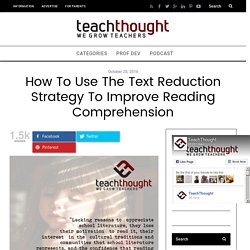
Engadine English Transition - Home. Integrating Technology and Literacy. When teaching with digital natives in a digital world, one question facing many educators revolves around integrating technology to help facilitate learning: How do you work technology into the pedagogy, instead of just using something cool? That task can be especially daunting in language arts literacy classrooms where reading and writing skill development is the crux of daily lessons. However, as 1:1 technology initiatives roll out, integrating technology into the classroom is our reality. With hundreds of sites, apps, Chrome extensions, and platforms available, choosing the right ones can seem overwhelming. As an eighth-grade language arts teacher, I've experienced this myself.
Following are four tools that can help provide immediate formative assessment data as well as top-of-the-rotation feedback to help students develop personal learning goals. 1. Registering is quick and free, whether via Google, Facebook, Twitter, Yahoo, or your own email account. 2. 3. 4. Visual Literacy. 01. © ALARM Introduction. 3 Strategies to Improve Student Writing Instantly. Editor's Note: A version of this post first appeared on Techie Teacher and Character Coach. "But Miss Parrish, I can't think of anything to write!
"